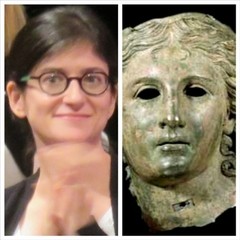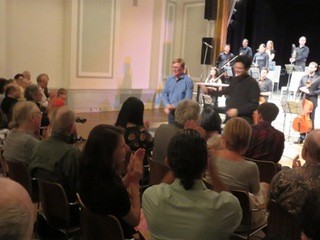|
Back
Luminous Music From The Black Hole New York
Czech Center (Bohemian National Hall)
09/19/2015 -
Tristan Murail: C’est un jardin secret, ma sœur, ma fiancée, une source scellée, une fontaine close... for viola – Les Ruines circulaires for clarinet and violin – Feuilles à travers les cloches for flute,violin, cello and piano
Giacinto Scelsi: Tre pezzi for E-flat clarinet – Anahit for violin and chamber orchestra
Georg Friedrich Haas: Introduktion und Transsonation for 17 instruments and tape
Stephanie Griffin (Viola), Doori Na, Hannah Hurwitz (Violins), Carol McGonnell, Vasko Dukovski (Clarinets), Lance Suzuki (Flute), Serafim Smigelsky (Cello)
Argento Chamber Ensemble, Michel Galante (Pianist, Conductor)

H. Hurwitz last night/Anahit in Istanbul Archeology Museum
(© Sam von Dogenstein)
One could say that the difference in universes between Miller Theater’s concert of music by Simon Steen-Andersen and last night’s concert by three closely-knit “spectralist” composers could have been the difference between day and night.
Except that day and night don’t exist in the universe. Rather, let’s say the difference was between the energy-hurling Big Bang music of Mr. Steen-Andersen, and the density of the (execrably-named) Black Hole.
Thursday’s concert gave a physical joy, a series of kicks up the derriére into the crazy portions of the cosmos. The music of Tristan Murail, Giacinto Scelsi and Georg Friedrich Haas was just the opposite. Instead of exploding notes and phrases and seeing where the particles would land (or if they would land), these composers took the resonances of single notes and pushing further and further together until we had sounds which were incidental to music.
Or, as Scelsi described himself, oh so humbly, “I am not a composer. I am a messenger between two worlds.”
Fortunately, he was indeed a composer, and his music was actually pictorial. Not like a Richard Strauss tone-poem but with visual poetry.
This was best shown in Anahit, actually a 14-minute violin concerto. Soloist Hanna\h Hurwitz was obviously the personification of Anahit, the Middle East version of Venus. Anahit has been claimed by pre-Christian Armenians, by Phrygians, Hittites and pre-Zoroastrian Persians, and throughout Turkey today, one sees remnants of her sacred cult.
This was sacred music as well. In a strange violin tuning of G-G-B-D, Ms. Hurwitz was asked to make it even stranger, playing basically in microtones–this against the essentially harmonic rule of the Argento Chamber Ensemble.
The result was an intense sound voyage. Not at all like the following “riff’ on Scelsi by Georg Friedrich Haas but a moving three-movement work with a short but mesmerizing cadenza also played in microtones. It demands perfection, total control, and yes, the emotional feeling which Ms. Hurwitz gave it.
The first half of the program was equally picturesque. The most lovely (probably the wrong word to use), three works for E-flat clarinet, also by Scelsi, showed that this composer might have been a romantic at heart. Played by the Argenta’s clarinetist, Carol McGonnell, it began with a simple tonic-dominant piece that could have been a children’s song, save for beeps in another register. The final short piece was like a variation on glissandi.
Three other works were by Tristan Murail. Not as long or involved as the piano work played by Kigawa last week, Les Ruines circulaires for clarinet and violin, was like the old Zen butterfly-dreaming-he-was-a-man-dreaming-he-was-like-a-butterfly, this, though, based on a Jorge-Luis Borges story, and here with violinist Doori Na “dreaming” about clarinetist McGonnell.
Equally picturesque was It is a secret garden, my sister, my bride, a sealed source, a fountain close... a fiercely lovely viola work played by Stephanie Griffin. The Leaves Through the Bells was pure image. Yes, Mr. Murail’s explanations are more musically interesting. But the aural rustling and bells played by violin, flute, cello and piano, nearly all in the highest register, was evocative enough to give a virtually literal sound to the title.

M. Galante, G.F. Haas, Argento Ensemble (© Sam von Dogenstein)
The last longest work was introduced by Georg Friedrich Haas, though the material came from Scelsi. The Italian composer, who spent most of his days playing a single note on the piano, and jotting his notes down, hid most of his jottings, though they recently discovered and obviously transformed by Mr. Haas.
Mr. Haas took much of this notation and made a static sound-scape whose score is like a picture itself. Mr. Galante first conducted this music, then sat down at the computer for the “transsonation”, changing the sounds, reversing, actually bringing in blazoning fanfares and soft elegiac passages, none of them really moving.
Composer Haas declared that such a composition was “not a question of an option. but of an aethestic necessity.”
I am happy he was compelled to do this, and, as in all the music, the depth and intensity could have been riveting. Frankly, during the whole performance, my memory harked back to Mr. Murail’s charmng (and equally complex) dream chasing dream chasing dream...
Romance, even in the deadness of a Black Hole core, never dies.
Harry Rolnick
|